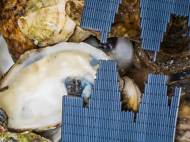Computation, 3D printing, and testing of bone-inspired composites
 Researchers at MIT have developed an approach that allows them to create physical sample of a multiscale computer model of a synthetic material. The approach allows creation of complex hierarchical patterns such as bones. The process could be scaled up to provide a cost-effective way to manufacture composite materials that are tailored for specific functions in different parts of a structure.
Researchers at MIT have developed an approach that allows them to create physical sample of a multiscale computer model of a synthetic material. The approach allows creation of complex hierarchical patterns such as bones. The process could be scaled up to provide a cost-effective way to manufacture composite materials that are tailored for specific functions in different parts of a structure.
Bones owe their strength and toughness to soft collagen proteins and stiff hydroxyapatite minerals which are arranged in patterns that change at every scale of the composite. MIT researchers replicated these patterns and used computer-optimized designs on a specialized 3D printer able to print two polymers at once in order to produce samples of synthetic materials that have fracture behavior similar to bones.
The collagen in bone is too soft and stretchy to serve as a structural material, and the mineral hydroxyapatite is brittle and prone to fracturing. However, when these two materials intertwine, they form a much more durable composite material. The hierarchical patterns help bone withstand fracturing by dissipating energy and distributing damage over a larger area, rather than letting the material fail at a single point.
“The geometric patterns we used in the synthetic materials are based on those seen in natural materials like bone or nacre, but also include new designs that do not exist in nature”, said Markus Buehler, associate professor at the Department of Civil and Environmental Engineering, who has done extensive research on the molecular structure and fracture behavior of biomaterials. “We can design our own, which may perform even better than the ones that already exist.”
Buehler and his team created three synthetic composite materials, each with dimensions of 0.32 x 12.7 x 17.8 cm (0.125 x 5 x 7 inches). The first sample simulates the mechanical properties of bone and nacre (also known as mother of pearl). This design has a microscopic pattern that looks like a staggered brick-and-mortar wall – a soft black polymer works as the mortar, and a stiff blue polymer forms the bricks. Another composite simulates the mineral calcite – with an inverted brick-and-mortar pattern featuring soft bricks enclosed in stiff polymer cells. The third composite has a diamond pattern resembling snakeskin – tailored specifically to improve upon one aspect of bone’s ability to shift and spread damage.
MIT team confirmed the accuracy of this approach by putting the samples through a series of tests to see if the new materials fracture in the same way as their computer-simulated counterparts. The samples passed the tests, validating the entire process and proving the efficacy and accuracy of the computer-optimized design. As predicted, the bonelike material proved to be the toughest overall. Bonelike specimen exhibited that it is 22 times more fracture-resistant than its strongest constituent material.
“The possibilities seem endless, as we are just beginning to push the limits of the kind of geometric features and material combinations we can print”, said Buehler, who hopes that eventually entire buildings might be printed with optimized materials that incorporate electrical circuits, plumbing and energy harvesting.
Combined with previous research of bone structure, this methodology allows study as well as potential improvement of bone nano-mechanics. The approach could be used to study brittle bone disease and other bone disorders, thus enabling many fundamental investigations.
For more information, read the paper published in Advanced Functional Materials: “Tough Composites Inspired by Mineralized Natural Materials: Computation, 3D printing, and Testing”.
For more information about the research related to bone structure, you can read the paper published in Nature Communications: “Molecular mechanics of mineralized collagen fibrils in bone” [1.27MB PDF].










Quite interesting. I believe this is the most advanced effort to create an artificial bone thus far, and hope that it could be used along advances in surgery.